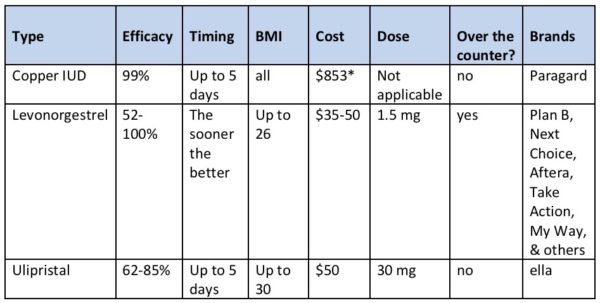Contraceptive Pearl: A Review of Emergency Contraception
There are 3 mainstays of treatment for emergency contraception: copper IUD, ulipristal acetate, and levonorgesterel. Emergency contraception prevents pregnancy after unprotected sex; it does NOT end a pregnancy and will not work if the patient is already pregnant.

*May be cheaper with 340B pricing or the Paragard Patient Assistance Program.
The copper IUD is the most efficacious form of emergency contraception. It can be used up to 5 days after unprotected sex to prevent pregnancy, and it works for patients of all BMIs.
Ulipristal Acetate mimics and blocks progestin, thereby delaying ovulation; it can be used for emergency contraception up to 5 days after unprotected sex. Ulipristal acetate is less effective in people who have a BMI>30.
Levonorgestrel is a high-does progestin hormone and delays ovulation as a means of emergency contraception; it can be used up to 5 days after unprotected sex, though it is more effective the sooner it is taken. Levonorgestrel is less effective in people who have a BMI>25.
Ulipristal acetate requires a prescription and is available at most pharmacies and health care centers; it generally costs about $50 for one dose, though many insurance plans cover ulipristal acetate. Clinicians should counsel patients that starting hormonal contraception immediately after taking ulipristal acetate may make both medications less effective.
Levonorgestrel does NOT require a prescription and is available over-the-counter for people of all ages. It generally costs about $50 for the branded product (i.e. Plan B One-Step) and $35-40 for generics (i.e. Aftera, Take Action, My Way, and others). Levonorgestrel should be covered by insurance with a prescription. The American Society for Emergency Contraception offers a Guide for Pharmacies and Retailers, which patients can present at the pharmacy if they experience difficulty rightfully accessing levonorgestrel emergency contraception over-the-counter.
Helpful Resources
Emergency Contraception: Which EC is Right for Me?
Emergency Contraception: A Guide for Pharmacies and Retailers
Sources
Pharma-free
The Reproductive Health Access Project does not accept funding from pharmaceutical companies. We do not promote specific brands of medication or contraception. The information in the Contraceptive Pearls is unbiased, based on science alone.

